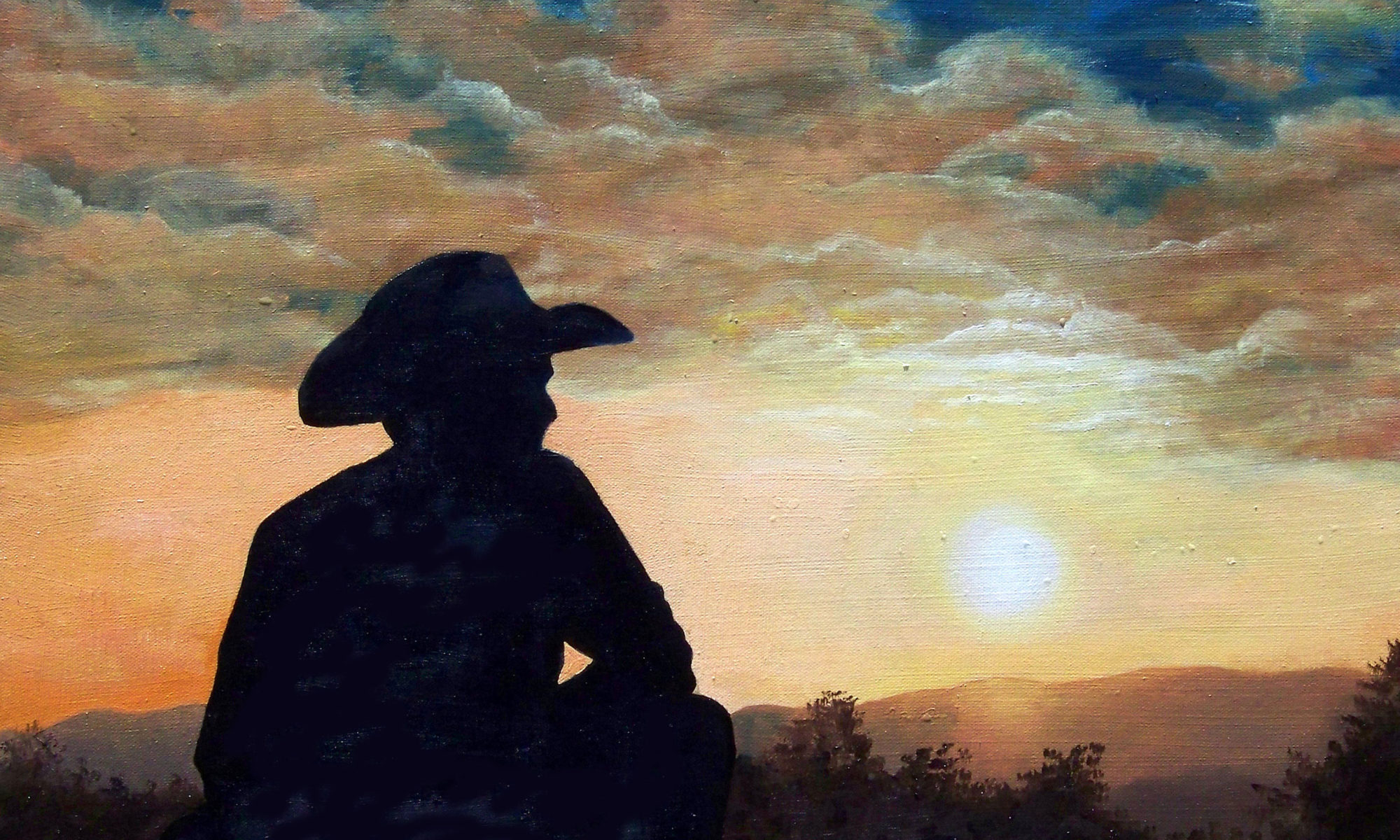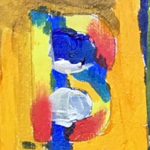
BACKGROUND | BUST
Quick links to more art terms and definitions are located at the end of the list.
Background
The area in a painting that visually appears far away in the distance at or near the horizon. It is usually located on a higher plane of the canvas.
Balance (in art)
Refers to the distribution of visual weight within a composition, creating a sense of harmony and stability. It’s a fundamental principle of design that ensures an aesthetically pleasing arrangement of elements. There are three types of balance, these are: symmetrical balance, asymmetrical balance, and radial balance.
Barbizon School
(Visual arts: painting. Art movement: France, 1830-1870.)
An art movement formed by a group of French landscape painters who sought to promote a more realistic and informal approach in their nature paintings. Named after the village of Barbizon near the Forest of Fontainebleau in France, this group of artists gathered there to create and find inspiration. Their artwork often depicted serene natural scenes, pastoral life, and agricultural laborers. The Barbizon School laid the groundwork for Modernism by focusing on personal expression. It anticipated the Impressionist movement, which also embraced a similar philosophical approach to art.
Baroque Art
(Pronounced buh-rohk. Visual arts: architecture, painting, and sculpture. Art movement: Western Europe, 17th and early 18th centuries. French term “barroque,” meaning “irregularly shaped.” Also known as Baroque period.)
An art movement characterized by exaggerated ornate detail. An extravagant style of art characterized by curving lines, gilding, and gold. The Baroque art style was sometimes considered excessively decorated and overly complicated. Baroque art emerged as a response to the simplicity of Protestant art and was popular with and supported by the Catholic Church.
Bauhaus School
(Pronounced bou-hous. Visual arts: design, architecture, and applied arts. Art movement: Germany, 1919-1933. A German word meaning “house of building.” Also known as Staatliches Bauhaus.)
A German art school established in Weimar, Germany in 1919. It aimed to unify crafts and fine arts by emphasizing function and mass production in design. It sought to merge crafts and fine arts, focusing on functionality and mass production in design. The school’s design ethos featured clean lines, geometric forms, and minimal decoration, complemented by vibrant primary color accents, aiming for elegance through simplicity. Nevertheless, the Nazis shut it down in 1933, prompting numerous artists to flee to the United States in search of intellectual freedom.
Basic Art Elements
See “Elements of Art.”
Byzantine Art
(Visual arts: architecture, mosaics, and painting. Art movement: Byzantine Empire, 4th-5th Century A.D.)
An art style rooted in Christianity and classical Greek mythology that was a significant artistic movement during the Middle Ages in the Byzantine Empire and surrounding areas. It focused on the Orthodox church, focusing on the painting of icons and decorating churches with frescoes and mosaics. Byzantine art was known for its intricate mosaics, often depicting flat figures against a golden background, aiming to convey spiritual and symbolic meaning. The art form favored stylized representations rather than naturalistic ones, using graceful figures and golden tesserae to create a sense of wonder and admiration for the church. The style ended with the fall of Constantinople to the Turks in 1453 during the European Renaissance, but its influence continued in Russia and other Orthodox countries where the church held sway.
Ben-Day Dots
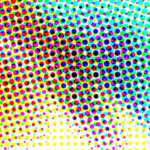
Tiny colored dots (cyan, magenta, yellow, and black) used in the commercial printing industry to create shading and secondary colors in images. Benjamin Henry Day, an illustrator and printer, invented this method in 1879.
Binder
A component in paint, such as linseed oil or acrylic polymer, that holds pigment particles together ensuring consistent uniformity or cohesiveness.
Biomorphic Art
An abstract art style first introduced in the mid-1930s that evokes the form and shape of natural and living organisms. It focuses on the power of natural life and uses shapeless, vaguely spherical hints of biology. Drawing inspiration from patterns and forms found in the natural world and living organisms, biomorphic art creates aesthetically pleasing and harmonious designs, blending Surrealism and Cubism. Also called “biomorphism” or “biomorphist” art.
Birds-Eye View
Seeing from the point of view from an altitude or a distance; a comprehensive view in a downward direction; also called an “aerial view.”
Bitmap Image
A pixel-based image (.BMP) with one bit of color information per pixel, also known as a bitmapped image. The only colors displayed in a bitmapped image are black and white. Its quality decreases when the image is enlarged.
Black
An achromatic color, without hue, results from the absence or complete absorption of any visible light. The darkest of all colors and the opposite or complement of white. It is often argued that black is not a color because it lacks any hue or wavelength of light. However, since color is the result of human perception, many commonly perceive black as a color. One of four primary ink colors used in the printing industry (cyan, magenta, yellow, and black).
Blending
A technique used in painting to soften lines and create a gradual transition between two or more colors or tones. Blending ensures that most surfaces appear smooth and have fewer hard edges.
Blending Brush
A type of paintbrush used for smoothing out brushstrokes and spreading and blending colors smoothly. Blending brushes are very soft and are not used for applying paint. Use them to gently stroke the wet paint that you have already applied to the canvas to remove brushstrokes and blend paint. These art brushes are usually the most expensive in your paintbox, so you will want to take good care of them to make them last a long time.
Blue

One of the three primary colors of pigments used in painting, and the complement or opposite of the color orange. Blue, when mixed with other hues, can be used to create a wide array of colors.
Body Art
A type of contemporary art that uses the human body as the “canvas.” The most common forms of body art are tattoos and body piercings.
Botanical Art
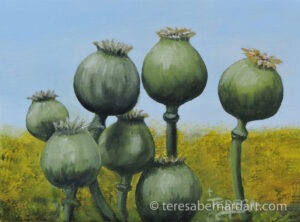
A scientifically accurate portrayal of a plant, fungi, or lichen, but may not be a comprehensive scientific record. It encompasses a variety of genres, including scientific illustration, realistic drawing, and painting of botanical subjects. The goal of botanical painters is to comprehend plant structure and visually express this information to their audience. For more on botanicals, click here.
Botanical Artist
A skilled artist who creates precise illustrations of plants, often used in scientific records and printed alongside descriptions in books and media. Their goal is to accurately document the shapes, structures, colors, life cycle, and habits of unique plant species while providing a visually appealing image.
Bright Art Brush
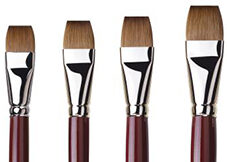
A brush with a flat ferrule and short-length hairs set in a long handle. The hairs curve inward at the tip and are virtually the same breadth and length as the brush head. This brush works well for applying heavy color in short, controlled strokes; however, if overworked, a Bright will remove as much paint as it applies. Use this brush when you want the brush strokes to show. These brush types are better for working up close rather than holding the brush at a distance from the canvas.
Bristle Brushes
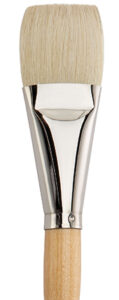
A natural hair paintbrush used by artists. Bristle brushes are stiff and springy brushes made from the hairs from the back of a pig. They have natural “split ends,” which make them ideal for oil painting because they can withstand heavy oil paint, textured canvas, and harsh solvents like turpentine. The stiff bristles will leave a strong mark on the canvas. In addition, Bristle brushes are easy to clean.
Bristle brushes, ideally half an inch wide or larger, are most effective for covering large canvas areas, starting a painting, or working on very large pieces. It’s possible to complete entire paintings exclusively with bristle brushes. For more intricate details in smaller sections, however, sable brushes are the recommended choice.
Bristles
Sometimes referred to as hairs or filaments, bristles make up the head of the brush, called the “brush head.” This is the part of the brush that holds the paint. They are made from natural hair, synthetic fibers, or a combination of both. Natural bristles are animal hair, while synthetic bristles are nylon or polyester.
Bristles are formed into different shapes, which dictate the type of brush: bright, fan, filbert, flat, and round. The quality of the bristles determines the cost of the brush. The tip of the bristles is called the toe, while the heel is where the strands go into the ferrule at the tip of the handle. The belly is the fattest part of the bristle head.
Bristol Board
A high-quality heavyweight drawing paper, sometimes made with cotton fiber prepared or glued together, usually with a caliper thickness of 0.006″ and up, used for many types of two-dimensional artwork, including lettering.
Brush Anatomy

The anatomy of an artist’s paintbrush consists of three main components: the head, the ferrule, and the handle.
Brush Head: The hairs or bristles of the brush. The strands are made from either natural or synthetic fibers. This is what an artist uses to apply and push paint around on the canvas. The head has three parts: the very tip of the head is called the toe. The fattest part is called the belly, and the point where the head meets the ferrule is called the heel.
Ferrule: The metal cylinder or band that attaches the head to the handle and helps hold the hairs in shape. Ferrules are made from a range of metals, including tin, aluminum, brass, copper alloys, nickel, and chrome plating. High-quality brushes have a brass or copper alloy ferrule that won’t rust or come loose. These types have the best adhesion to the handle and a double or triple crimp. The crimp is the part of the ferrule that secures it to the handle. This is important because if the ferrule does not fit properly, the bristles will fall out, or the ferrule could come off the handle.
Handle: Refers to the brush’s long stem, held during painting. Brush handles typically are made from materials like wood, acrylic, or bone, however, most handles are made from hardwoods such as beech. Their lengths vary and differ from manufacturer to manufacturer. Short handles are designed to fit comfortably in the palm, facilitating various painting techniques and movements. In contrast, oil painting brushes typically have longer handles to provide better balance. The size of a paintbrush is usually indicated by a number on the handle, starting from 000 (the smallest size), followed by 0, 1, 2, and so on, increasing to larger sizes. Regardless of size, a quality brush will balance on your finger.
See “paintbrush” for more information about brushes.
Brush Drawing
A technique in visual arts that uses a round and pointed brush to produce linear images using India ink or watercolor. This style is very useful for illustrating nature objects since it produces a linear feel rather than a painterly finish. Brush drawing is ideal for generating delicate and detailed images.
Brushstroke
The mark left by a loaded (filled) brush on a surface. Brushstrokes are characterized by their direction, thickness, texture, and overall quality. Some artists purposefully obscure individual brushstrokes to achieve a smooth surface. Other artists make their brushstrokes obvious to reveal the process of painting or to express movement or emotion.
Brushwork
The technique of applying paint to a surface using a brush. It’s a fundamental aspect of painting and significantly influences the overall look and feel of a piece of art. Artists can vary their brushwork style, from smooth and controlled strokes to loose and expressive marks. The way an artist uses their brush can convey different textures, emotions, and visual interest in their work. Every painter has a different brush technique that adds to an artist’s style and distinguishes their work.
Built Environment
Man-made surroundings created to fulfill human desires and needs. Structures, features, and facilities viewed collectively as a setting for human activity in which people live, work, and play.
Bust
In sculpture, a representation of the upper part of the human figure, including the head, neck, and part of the shoulders and breast. The bust is a type of portrait that aims to capture the likeness of an individual, often (but not exclusively) displayed atop a pedestal or column.
You May Also Like
This glossary of art terms and definitions is provided as a valuable resource for art enthusiasts. If you like the information here and find it helpful, please consider purchasing a painting. Your support helps to cover the cost of keeping this art vocabulary, terms and definitions lexicon online. Simply click or tap the thumbnail link of any Teresa Bernard oil painting to view additional details.
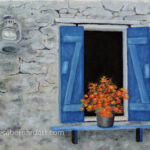
(2022)
12″ w x 9″ h
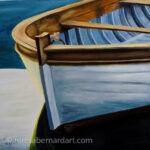
(2021)
18″ w x 18″ h
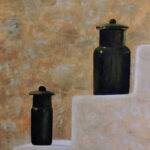
12″ w x 9″ h
Art Glossary Quick Links
Contributing to The Art Dictionary
The dictionary of art definitions is a work in progress. We regularly update it with new additions. If you know of an art term and definition that isn’t already listed in it, but believe it should be, please forward it to us for our review. We’ll notify you upon its inclusion. Thank you!
Thanks for reading this!
